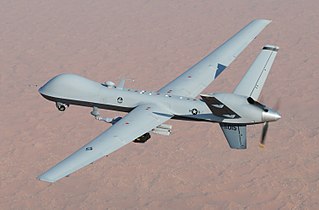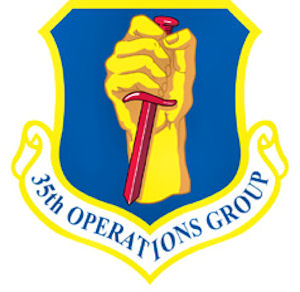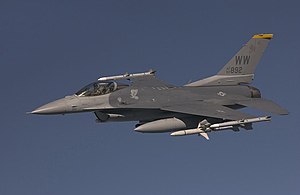
The 67th Cyberspace Operations Group is a unit of the 67th Cyberspace Wing. Headquartered on Kelly Field Annex's Security Hill, the group is an Air Force information operations unit.

The 11th Attack Squadron is a United States Air Force unit assigned to the 432d Wing Air Combat Command at Creech Air Force Base near Indian Springs, Nevada. It flies General Atomics MQ-9 Reaper Unmanned aerial vehicles. In 1995 the 11th became the first Remotely Piloted Aircraft (RPA) squadron in the Air Force.

15th Attack Squadron is a United States Air Force unit assigned to the 432d Wing, 732nd Operations Group at Creech Air Force Base near Indian Springs, Nevada. It flies the General Atomics MQ-9 Reaper remotely piloted aircraft.

The 17th Attack Squadron is a squadron of the United States Air Force. It is assigned to the 432d Wing, and stationed at Creech Air Force Base in Indian Springs, Nevada. The 17th is equipped with the MQ-9 Reaper.

The 26th Information Operations Wing is an inactive United States Air Force unit. Its last assignment was with United States Air Forces in Europe at Ramstein Air Base, Germany, where it was inactivated on 5 July 2006.

The 20th Intelligence Squadron is a United States Air Force unit, assigned to the 363d Intelligence, Surveillance, and Reconnaissance Group at Offutt Air Force Base, Nebraska. It has served at Offutt since June 1992, when it was activated as the 20th Air Intelligence Squadron.

The 312th Aeronautical Systems Group is an inactive United States Air Force unit. It was last active in June 2010 at Wright-Patterson Air Force Base, Ohio, where it was a component of Air Force Materiel Command.

The 13th Fighter Squadron is a fighter squadron of the United States Air Force. The squadron flies the General Dynamics F-16 Fighting Falcon and is part of the 35th Fighter Wing at Misawa Air Base, Japan.

The 13th Reconnaissance Squadron is part of the 926th Wing at Beale Air Force Base, California. It operates RQ-4 Global Hawk unmanned aircraft conducting reconnaissance and surveillance missions.

The 25th Attack Group is an active United States Air Force unit, stationed at Shaw Air Force Base, South Carolina. It was activated in February 2018 as a geographically separate unit to operate unmanned aerial vehicles and is assigned to the 432d Wing, which is located at Creech Air Force Base, Nevada. As of 2020, the group manages five General Atomics MQ-9 Reaper attack squadrons, as well as the 25th Operations Support Squadron, which provides intelligence, weather, and administrative support.

The 69th Reconnaissance Group is an inactive United States Air Force that was part of Air Combat Command, the group was stationed at Grand Forks Air Force Base, North Dakota where it was a tenant of the 319th Air Base Wing.

The 6th Air Intelligence Squadron is an inactive unit of the United States Air Force. Its last assignment was with Seventh Air Force, stationed at Osan Air Base, Korea. It was inactivated in 1993. The unit was originally established at Army Air Base, Colorado Springs, Colorado as the 6th Photographic Group on 5 February 1943, under the command of Lt Waymond Davis. Later that year, the unit was redesignated the 6th Reconnaissance Group and deployed to the southwest Pacific as a component of the Fifth Air Force.

The 386th Tactical Fighter Squadron is an inactive United States Air Force unit. Its last assignment was with the 312th Tactical Fighter Wing, based at Cannon Air Force Base. New Mexico. It was inactivated on 18 February 1959.

The 20th Attack Squadron is a United States Air Force unit, based at Whiteman Air Force Base, Missouri. It currently flies the General Atomics MQ-9 Reaper and is assigned to the 432d Wing at Creech Air Force Base, Nevada.

The United States Air Force's 543d Intelligence, Surveillance and Reconnaissance Group is an intelligence unit located at Joint Base San Antonio, Texas. It has been located there since 1997, when it was activated as the 543d Intelligence Group. It focuses on cryptologic operations and signals intelligence.

The 43d Electronic Combat Squadron is a United States Air Force unit. Its current assignment is with the 55th Electronic Combat Group, being stationed as a tenant unit at Davis-Monthan Air Force Base, Arizona as a geographically separated unit from its parent, the 55th Wing at Offutt Air Force Base, Nebraska. It operates the EA-37B communications-jamming aircraft.

The 35th Operations Group is the operational flying component of the United States Air Force 35th Fighter Wing. It is stationed at Misawa Air Base, Japan, and is a part of Pacific Air Forces (PACAF).

The 29th Attack Squadron is a remotely piloted vehicle training unit of the United States Air Force. Assigned to the 49th Operations Group, 49th Wing at Holloman Air Force Base, New Mexico. Flying the General Atomics MQ-9 Reaper. It was activated on 23 October 2009.

The 2nd Troop Carrier Squadron is an inactive United States Air Force unit. It was last active in the reserve with the 65th Troop Carrier Group at Mitchel Air Force Base, New York where it was training with Curtiss C-46 Commandos. It was replaced by another unit, which absorbed its resources on 1 April 1953.

The 62d Expeditionary Attack Squadron is a provisional United States Air Force unit. It is a provisional squadron of Air Combat Command, attached to the 432d Air Expeditionary Operations Group, stationed at Creech Air Force Base, Nevada. The primary mission of the 62d EATKS is to launch and recover all the Air Force Remotely Piloted Aircraft in Afghanistan.


























